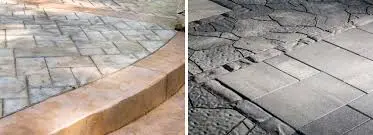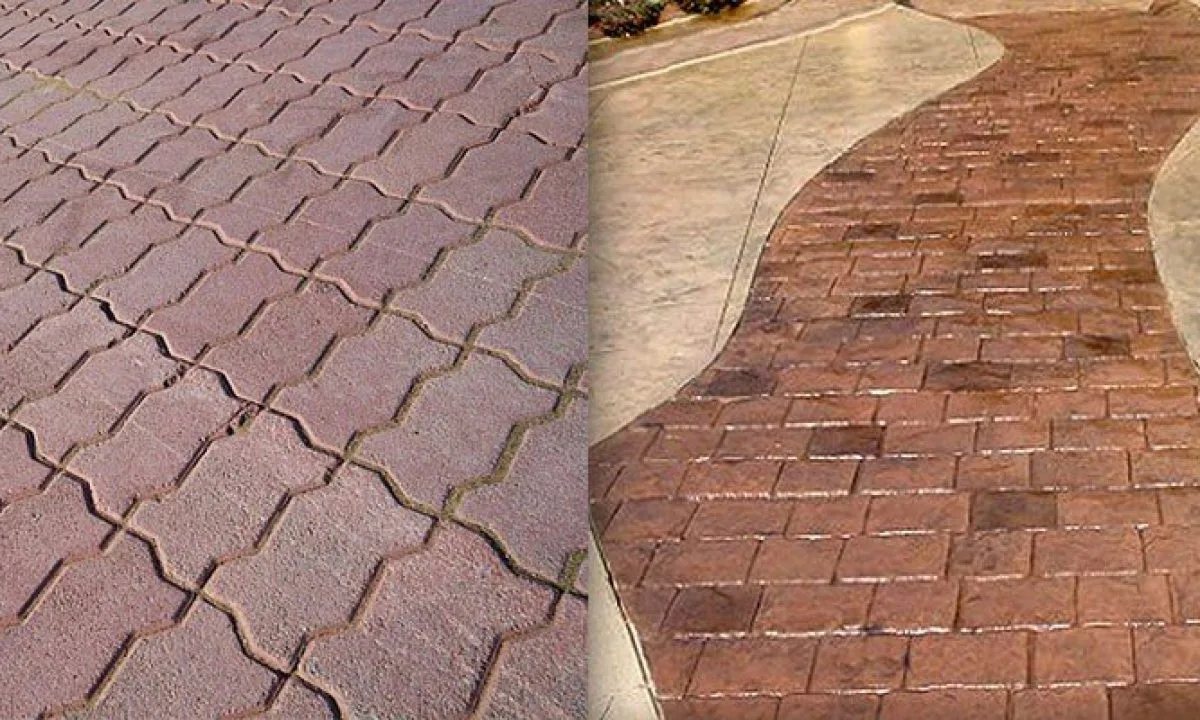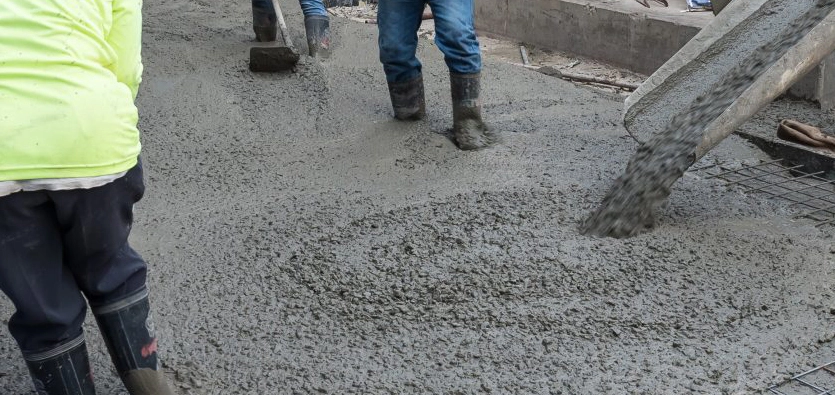Maintenance Tips for Stamped Concrete Surfaces
Stamped concrete offers a versatile, cost-effective solution for enhancing outdoor spaces with natural stone, brick, or wood. Let's delve into the world of stamped concrete and explore its benefits for landscaping and construction projects.
Stamped concrete surfaces boast many patterns and colors, allowing homeowners and contractors to customize their projects to suit any style or aesthetic. The possibilities are endless, from intricate cobblestone designs to sleek slate textures. This versatility makes stamped concrete ideal for driveways, patios, walkways, pool decks, and more.
One of the primary benefits of using stamped concrete is its affordability compared to traditional materials like natural stone or brick. Property owners can achieve the desired look at a fraction of the cost by utilizing concrete and imprinting techniques. Additionally, stamped concrete requires minimal maintenance, saving time and money in the long run.
The lifetime and resilience of stamped concrete are another benefit. Stamped concrete surfaces resist fading and deterioration when placed and maintained correctly. They can also endure severe weather and UV exposure. This makes it an excellent investment for outdoor spaces that experience high levels of use.
Additionally, stamped concrete has good traction, which lowers the possibility of slips and falls, particularly near entryways or pool areas. Its non-porous surface also resists stains, making cleanup a breeze. With proper sealing, stamped concrete can repel water, oil, and other contaminants, ensuring a beautiful and functional outdoor space for years to come.
Whether enhancing your home's curb appeal or creating a stylish outdoor entertaining area, stamped concrete offers endless possibilities for transforming your space.
Neglecting maintenance can lead to many issues that detract from the appearance and durability of these decorative features. Let's explore why regular maintenance is crucial for stamped concrete.

First and foremost, routine maintenance helps to protect the surface of stamped concrete from wear and tear caused by foot traffic, weather exposure, and other environmental factors. Property owners can regularly clean and seal stamped concrete to prevent dirt, grime, and moisture from penetrating the surface and causing damage over time.
Furthermore, proper maintenance helps maintain the vibrant colors and intricate stamped concrete patterns. Without regular cleaning and sealing, stamped concrete surfaces may become dull, faded, or discolored, detracting from their aesthetic appeal. Property owners can ensure that their stamped concrete remains visually stunning for years to come by investing in routine maintenance.
Neglecting maintenance can also negatively impact the durability of stamped concrete surfaces. Over time, dirt, debris, and moisture can accumulate on stamped concrete's surface, leading to mold, mildew, and algae growth.
Property owners can protect their investment by investing in routine cleaning and sealing and enjoy beautiful, long-lasting stamped concrete for years. Don't overlook the importance of maintenance—keep your stamped concrete looking its best with regular care and attention.
PropertyBy implementing simple cleaning practices, property owners can keep their stamped concrete fresh and vibrant for years. Let's explore three essential cleaning techniques to preserve the appearance of stamped concrete.
Firstly, sweeping and debris removal is crucial for preventing dirt, leaves, and other debris from accumulating on the surface of stamped concrete. Regularly sweeping the area helps avoid scratches and abrasions caused by abrasive particles while minimizing the risk of stains and discoloration.
Secondly, washing stamped concrete with a mild detergent and water solution helps to remove stubborn dirt, grime, and stains. Mix a small amount of mild detergent with water, then gently scrub the surface with a soft-bristled brush or mop to scrub the surface gently. Avoid harsh chemicals or abrasive cleaners, damaging the concrete and compromising its integrity.
Lastly, removing stains promptly is essential to prevent discoloration and permanent damage to the stamped concrete. Common stains like oil, grease, and rust can mar the appearance of stamped concrete if left untreated. To remove stains, apply a specialized concrete cleaner or poultice to the affected area, then scrub gently with a brush or sponge.
Sealing stamped concrete
Sealing stamped concrete primarily aims to create a protective barrier that shields the surface from wear and tear caused by foot traffic, weather exposure, and other environmental factors. Sealing helps to prevent moisture from penetrating the concrete, which can lead to cracking, spalling, and other forms of deterioration. Additionally, sealants enhance the color and sheen of stamped concrete, giving it a vibrant and polished appearance.
Sealing stamped concrete is a crucial step in preserving its appearance and durability. By applying a protective sealant, property owners can enhance the strength and longevity of their stamped concrete surfaces while safeguarding against stains, moisture penetration, and UV damage. Let's delve into the importance of sealing stamped concrete and explore some critical considerations.
Damage and cracked stamps
Common types of damage to stamped concrete include cracks, chips, and surface imperfections. Cracks may occur due to freeze-thaw cycles, soil movement, or heavy loads. Chips can result from impact or abrasion, while surface imperfections may develop over time due to wear and tear.
The extent of the damage. Depending on the damage, repair when repairing larger cracks, or extensive damage, it's advisable to seek professional assistance. An experienced contractor can determine how much damage has been done and suggest the best course of action for repairs. Repair methods could include overlay application, full-depth replacement, or epoxy injection.
Repairing cracks and damage in stamped concrete is crucial for preserving its appearance and structural integrity. Property owners should be vigilant in identifying common types of damage and addressing minor issues promptly.
Using mats or rugs in high-traffic areas such as entryways and patios helps minimize wear and tear on stamped concrete surfaces. Mats or rugs can also help prevent moisture and dirt from being tracked onto the stamped concrete, reducing the likelihood of stains and discoloration.
Avoiding harsh chemicals and de-icing agents is essential for preserving the integrity of stamped concrete surfaces. Chemicals such as bleach, ammonia, and acidic cleaners can damage the surface of stamped concrete and compromise its sealant. Instead, property owners should opt for gentle, pH-neutral cleaners specifically formulated for use on stamped concrete.
Proper landscaping techniques can also help to prevent damage to stamped concrete surfaces. Additionally, be mindful of sprinkler systems and drainage patterns to prevent water from pooling or seeping under the stamped concrete, which can lead to erosion and structural damage over time.
Seasonal upkeep is essential for stamped concrete surfaces to remain beautiful and intact all year long. Property owners can protect their stamped concrete from damage and ensure its longevity by adjusting maintenance routines based on weather conditions and implementing special considerations for each season. Let's explore seasonal maintenance tips to keep stamped concrete looking its best.
Special considerations are needed in winter to protect stamped concrete from the harsh effects of freezing temperatures, snow, and ice. Property owners should avoid using de-icing agents containing salt or other corrosive substances, as these can damage the surface of stamped concrete. Instead, opt for non-corrosive de-icing alternatives and promptly remove snow and ice to prevent moisture from seeping into the concrete and causing damage.
During the spring and summer months, regular cleaning and sealing become even more critical to protect stamped concrete from UV radiation, heat, and humidity. Property owners should sweep away debris, wash the surface with a mild detergent and water solution, and reapply sealant to maintain optimal protection and appearance.
In fall, clearing leaves, branches, and other organic debris that can accumulate on stamped concrete surfaces is essential. Additionally, property owners should inspect the stamped concrete for any signs of damage or wear and address any issues before winter sets in.
By following seasonal care recommendations and keeping a watchful eye throughout the year, property owners can safeguard their investments and enjoy gorgeous stamped concrete for years.
FAQs
1. What is stamped concrete?
Stamped concrete is A decorative surface resembling natural elements like stone, brick, or wood. It involves imprinting patterns onto freshly poured concrete before it sets, creating a customized and aesthetically pleasing finish.
2. How long is staIf installed and maintained correctly, stamped concrete good for?
Stamped concrete has a long lifespan. Factors such as climate, level of use, and maintenance routines can influence the lifespan of stamped concrete surfaces.
3. Can stamped concrete be repaired?
Yes, stamped concrete can be repaired to address minor damage, such as cracks, chips, or surface imperfections. T techniques such as patching, overlay application, or epoxy injection can restore stamped concrete's appearance and structural integrity.
4. Is stamped concrete slippery?
While stamped concrete surfaces can become slippery when wet, adding texture during stamping can help improve traction. Proper sealing and regular cleaning can further reduce the risk of slips and falls.
5. What is the price of stamped concrete?
The area's size, the pattern's intricacy, and the material selection affect stamped concrete costs. Generally, stamped concrete is more affordable than natural stone or brick, making it a cost-effective option for enhancing outdoor spaces.
Conclusion
In conclusion, stamped concrete offers a versatile and cost-effective solution for enhancing outdoor spaces with the look of natural stone, brick, or wood. Its customizable patterns and colors make it ideal for various landscaping and construction projects, from driveways and patios to pool decks and walkways. Property owners can enjoy beautiful and durable outdoor surfaces for years by investing in stamped concrete and implementing proper maintenance and preventative measures. Contact us as a trusted contractor for a consultation on enhancing your outdoor space with stamped concrete. Whether you want to revitalize an existing surface or embark on a new project, a professional can provide guidance and expertise to help you achieve your desired outcome. Don't wait any longer—transform your outdoor space with stamped concrete today.




